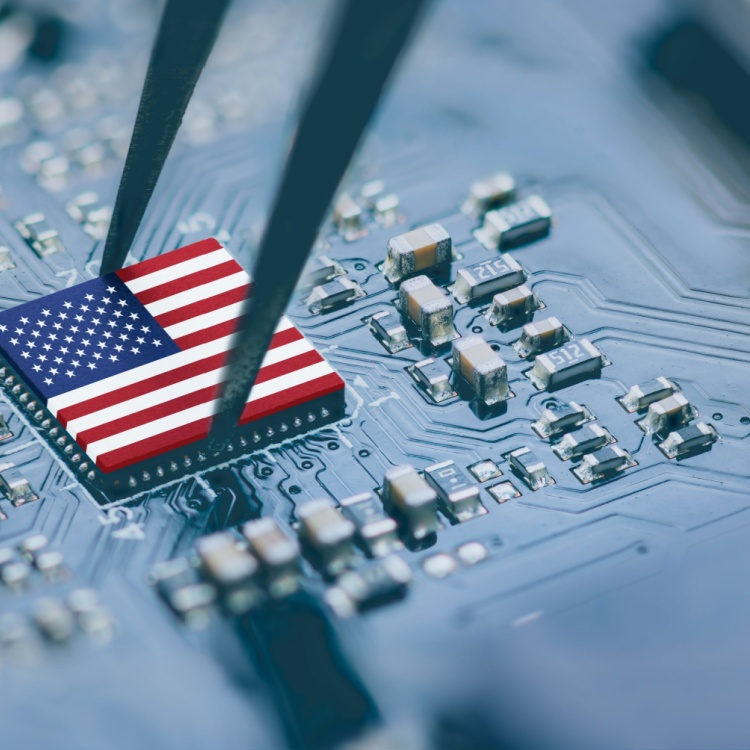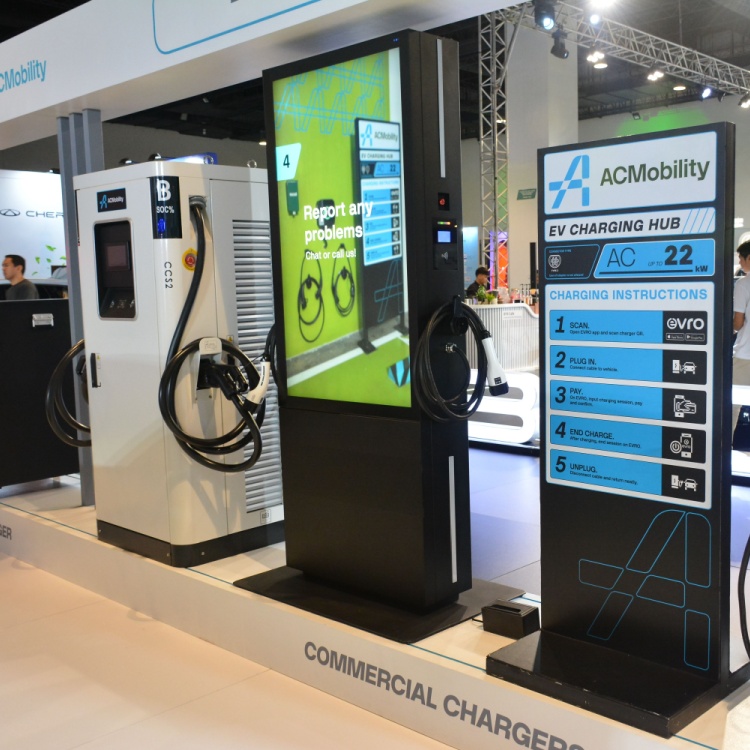Is the hydrogen economy hope or hype? Discover how it could enable a greener future.
As the world battles climate change and races to net zero, hydrogen is being hailed as the fuel of the future that could help end our dependence on fossil fuels. Learn the science behind hydrogen fuel cells and how this technology could enable carbon-heavy industries to switch to clean energy.
The science behind hydrogen fuel cells
As defined by the Fuel Cell and Hydrogen Association (FCHEA), a fuel cell is “a device that generates electricity through an electrochemical reaction, not combustion. In a fuel cell, hydrogen and oxygen are combined to generate electricity, heat, and water.”
A fuel cell is composed of two plates, the anode and the cathode, that are separated by an electrolyte membrane. Hydrogen is passed through the anode, while oxygen is passed through the cathode. At the anode, the hydrogen atoms are split into protons and electrons by a catalyst. The electrons are diverted to an external circuit, generating a flow of electricity and excess heat. Meanwhile, the protons pass through the membrane towards the cathode and combine with oxygen and the electrons to produce water.
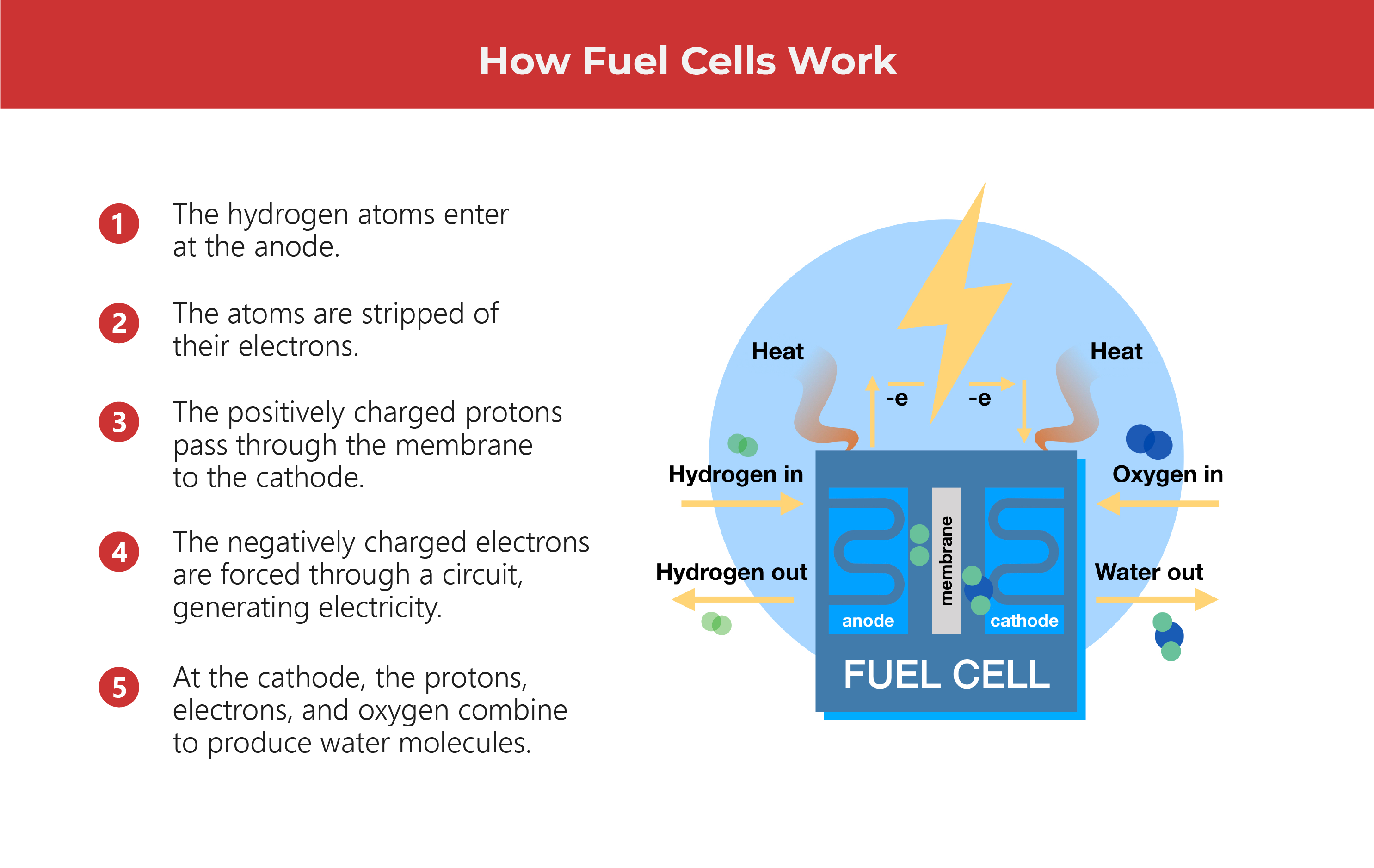
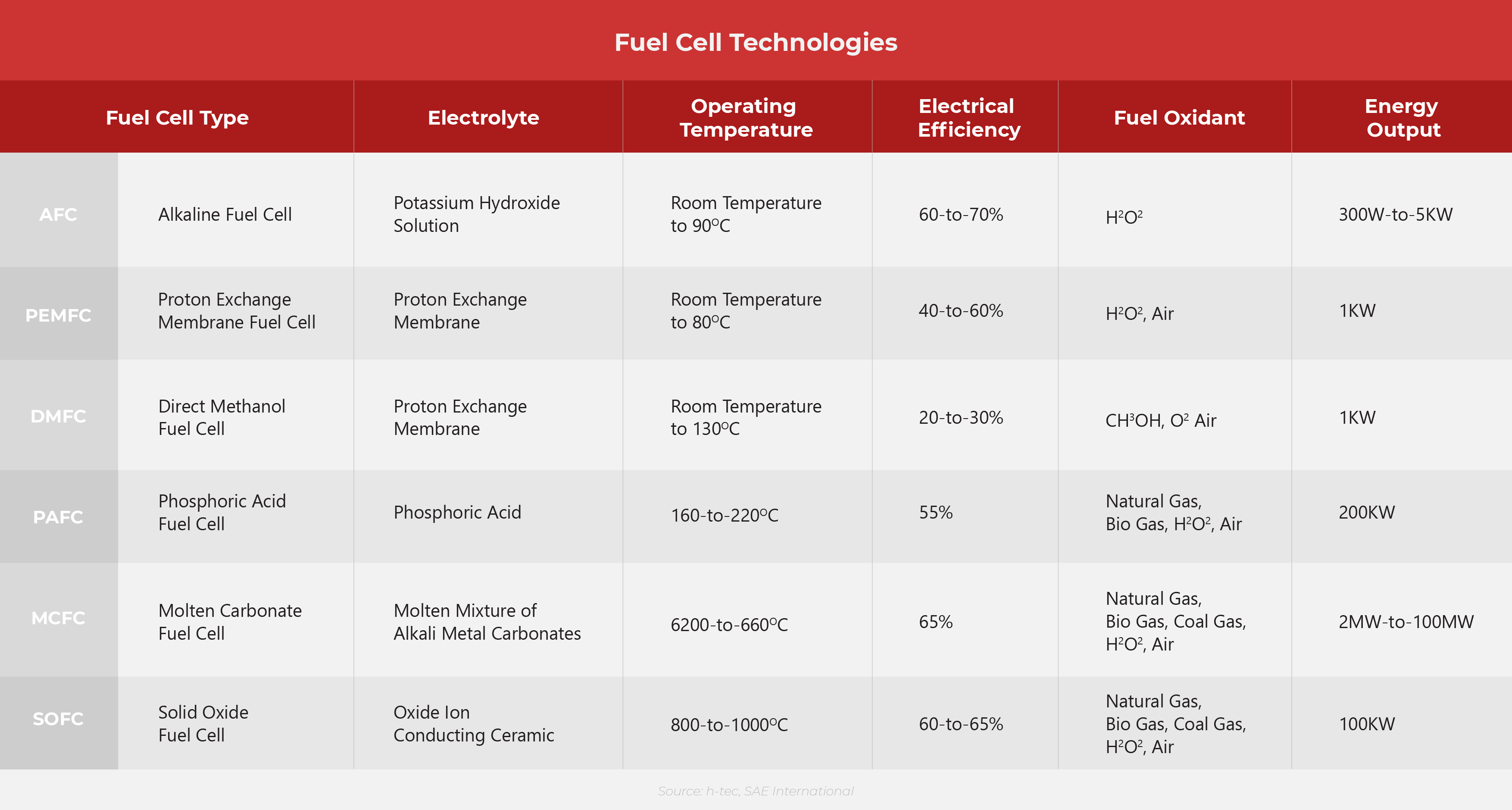
Compared to conventional combustion-based technologies being used in the energy and transport industry today, hydrogen fuel cells offer many benefits. But like any nascent technology, it also has its drawbacks. Let’s take a look at the pros and cons.
Hydrogen fuel cells: pros and cons
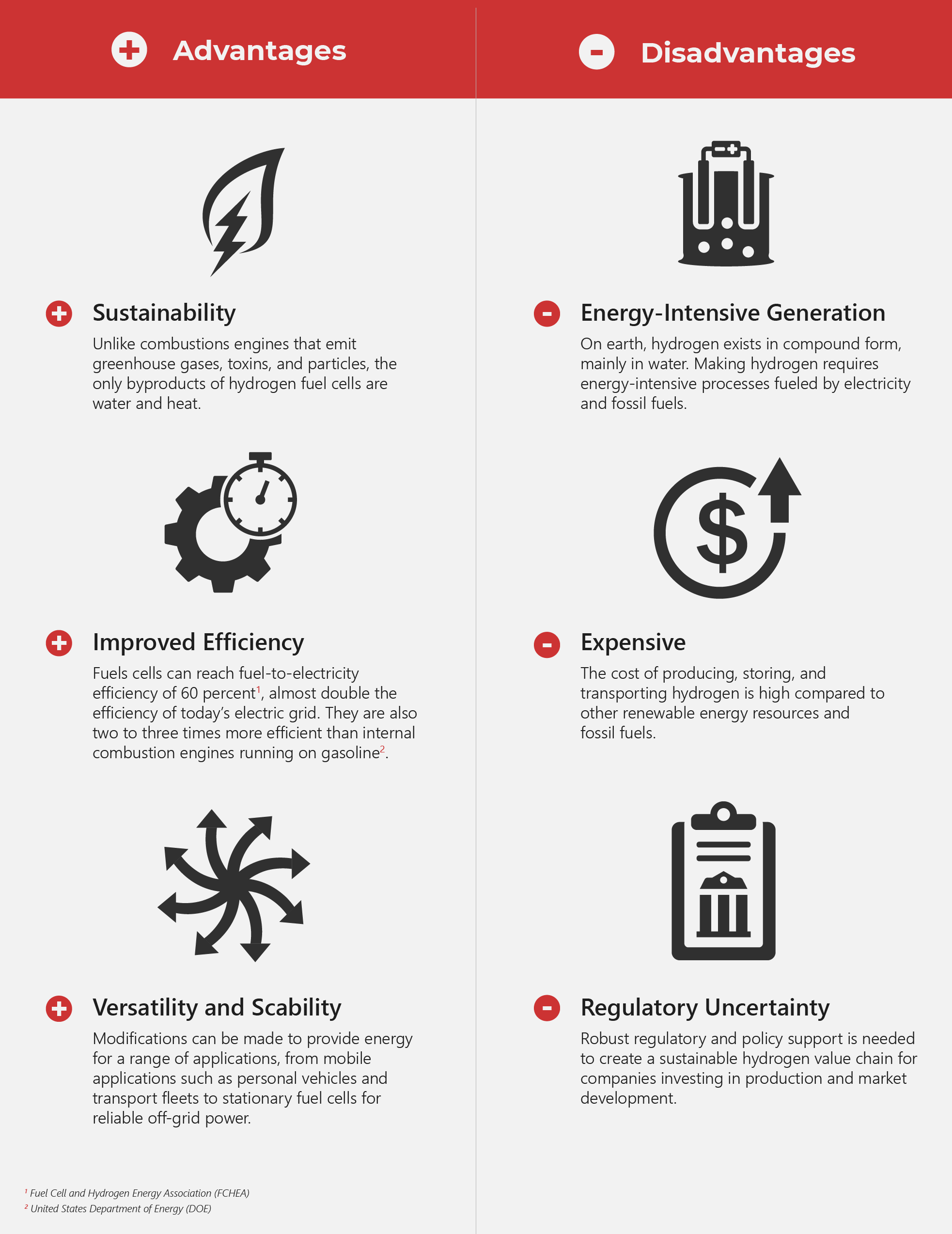
A path to decarbonizing industries
Admittedly, there are many obstacles to the large-scale adoption of hydrogen fuel cell technology. But it has immense potential to provide completely green energy solutions that are critical to net zero by 2050.
(Also read: COP26: Lessons Learned About Creating a Net Zero Future)
This is especially true for decarbonizing industries that are difficult to electrify, which include heavy industry (particularly chemical production and steel manufacturing), heavy-duty road transport, aviation, and shipping.
“There are a lot of applications where electricity is simply the best to use and more efficient,” says Vijay Vaitheeswaran, global energy and climate innovation editor for The Economist. “But there are other applications in heavy industry, particularly, or long-distance transport, for example, where hydrogen could find a niche and quite a big niche.”
Let’s look at how hydrogen has begun powering these industries today.

Hydrogen-powered trains
In 2018, the world’s first hydrogen-powered trains began operations in Lower Saxony, Germany. Built by French manufacturer Alstom, the Coradia iLint trains run a 100-kilometer route, can reach speeds of up to 140 kilometers per hour, and can travel around 1,000 kilometers on a tank of hydrogen.

By the end of February 2020, the two trains had run for 530 days and traveled 180,000 kilometers, marking their successful trial operation.
"Our two pre-series trains of the Coradia iLint have proven over the past year and a half that fuel cell technology can be used successfully in daily passenger service. This makes us an important driving force on the way to emission-free and sustainable mobility in rail transport", shares Jörg Nikutta, Managing Director for Germany and Austria of Alstom Transport Deutschland GmbH. "We have also obtained valuable data from the trial operation of the fuel cell trains for the further development of the propulsion technology."
According to analysts at Morgan Stanley, the European hydrogen train market could be worth USD 24 to 48 billion by 2050. “Europe will definitely be the main market,” Alstom Chief Executive Officer Henri Poupart-Lafarge said during a company webinar. He added that while infrastructure and fuel supply still need to be expanded, “the trains are ready.”
Hydrogen-powered boats
With around 90% of the world’s traded goods transported by sea, the shipping industry emits 2.89% of the world’s carbon dioxide. Hydroville, the world’s first hydrogen-powered passenger vessel, could help change that.
The 16-passenger shuttle was launched in 2017, transporting passengers between Kruibeke and Antwerp in Belgium. According to their website, the Hydroville will be “mainly used as a platform to test hydrogen technology for commercial seagoing vessels.”
“We decided for ourselves, look, we have to start with it today, even though there is no demand yet,” Roy Campe, managing director at CMB.Tech, told the BBC. “We have to start today to make certain that within 10 years we can already start producing all our ships on a low-emission level. It's not a light switch that you just flip over.”
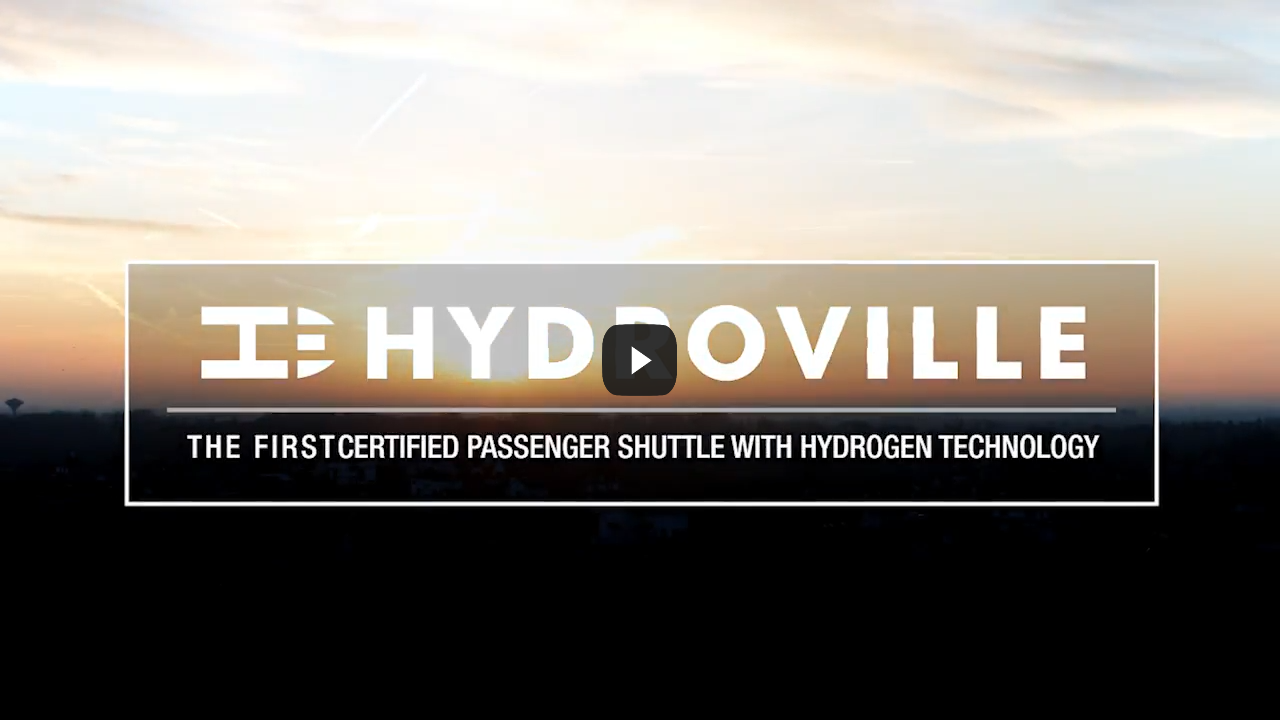
Fuel cell electric vehicles (FCEVs)
“We are convinced that a world where road transportation is fuelled by both batteries and fuel cells is better than one that relies on only a single technology,” says the Hydrogen Council in its study, Roadmap towards zero emissions: the complementary role of BEVs and FCEVs.
Leveraging the strengths of both BEV and FCEV technologies, we can make our streets carbon-neutral faster and cheaper. The study, which received analytical support from McKinsey and Company, identifies FCEVs as the best option for the following use cases:
- Areas with constrained renewables or limited grid capacity in the mid-to-long term
- High power and energy demand vehicle segments
- Customer segments with a preference for long range and fast refueling
China, the world’s largest producer of hydrogen, is giving the FCEV industry strong support through new policies. In 2020, it dominated global stocks in fuel cell buses (93%) and commercial vehicles (99%).
“Currently, the fuel cell vehicles account for less than 5% of the commercial truck market in China and that could grow to about one-third of total market share in 2050,” JPMorgan Analyst Elaine Wu shared with CNBC.
(Also read: 6 Tips for a Smaller Transportation Footprint)

Fossil-free steel
Steel is one of the most essential materials in the world, necessary for buildings and infrastructure, vehicles, and appliances. But it was also responsible for seven to nine percent of global carbon dioxide emissions in 2020. In Sweden, three industrial companies are hoping to change that.
HYBRIT, a joint venture between SSAB, LKAB, and Vattenfall, was founded in 2016. Its goal was to use fossil-free electricity and hydrogen rather than coking coal in steel production.
Last August, it produced the world’s first fossil-free steel and delivered it to the Volvo Group, which will be using it in the production of prototype vehicles and components.
“The first fossil-free steel in the world is not only a breakthrough for SSAB, it represents proof that it’s possible to make the transition and significantly reduce the global carbon footprint of the steel industry,” says Martin Lindqvist, President and CEO of SSAB. “We hope that this will inspire others to also want to speed up the green transition.”

Hydrogen-powered homes
Hydrogen technology isn’t just for multinational companies and the world’s biggest industries. In the race to net zero, every person can make a difference, no matter their age. Hans Olof Nilsson, a retired engineer, has built the world’s first 100% autonomous home in Gothenburg, Sweden. It is powered by the sun and hydrogen.
There are 160 square meters of solar panels on the roof, providing the home with electricity all year. Surplus solar energy stored in batteries is used during the night. Nilsson also has an electrolyzer for producing and storing hydrogen in winter.
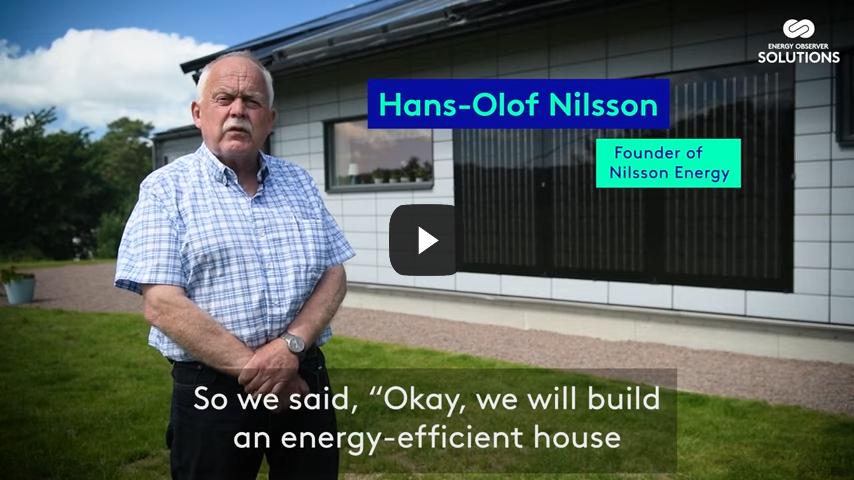
Fueling a greener future
Technologies for producing, storing, and using hydrogen are still nascent, with many trailblazers in the product and market testing phase. But, this will change when first-series products are introduced to all market segments.
With over 200 large-scale hydrogen projects in the pipeline globally, the time is ripe for the hydrogen economy to redraw the world’s energy map. As technological advances make hydrogen production more efficient and governments strengthen their commitments to decarbonization, we can build the energy system of a cleaner, more resilient future.
As one of the Top 21 EMS companies in the world, IMI has over 40 years of experience in providing electronics manufacturing and technology solutions.
We are ready to support your business on a global scale.
Our proven technical expertise, worldwide reach, and vast experience in high-growth and emerging markets make us the ideal global manufacturing solutions partner.
Let's work together to build our future today.




![]()
